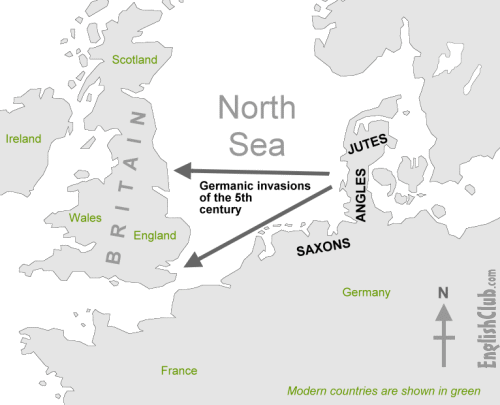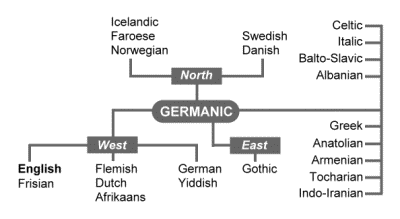Philip Durkin, Principal Etymologist at the
Oxford English Dictionary, chooses five events that shaped the English Language.
The Anglo-Saxon Settlement

It's never easy to pinpoint exactly when a specific language began,
but in the case of English we can at least say that there is little
sense in speaking of the English language as a separate entity before
the Anglo-Saxons came to Britain. Little is known of this period with
any certainty, but we do know that Germanic invaders came and settled in
Britain from the north-western coastline of continental Europe in the
fifth and sixth centuries. The invaders all spoke a language that was
Germanic (related to what emerged as Dutch, Frisian, German and the
Scandinavian languages, and to Gothic), but we'll probably never know
how different their speech was from that of their continental
neighbours. However it is fairly certain that many of the settlers would
have spoken in exactly the same way as some of their north European
neighbours, and that not all of the settlers would have spoken in the
same way.
The reason that we know so little about the linguistic situation in
this period is because we do not have much in the way of written records
from any of the Germanic languages of north-western Europe until
several centuries later. When Old English writings begin to appear in
the seventh, eighth, and ninth centuries there is a good deal of
regional variation, but not substantially more than that found in later
periods. This was the language that Alfred the Great referred to as
‘English’ in the ninth century.
The Celts were already resident in Britain when the Anglo-Saxons
arrived, but there are few obvious traces of their language in English
today. Some scholars have suggested that the Celtic tongue might have
had an underlying influence on the grammatical development of English,
particularly in some parts of the country, but this is highly
speculative. The number of loanwords known for certain to have entered
Old English from this source is very small. Those that survive in modern
English include
brock (badger), and
coomb a type of valley, alongside many place names.
The Scandinavian Settlements

The next invaders were the Norsemen. From the middle of the ninth
century large numbers of Norse invaders settled in Britain, particularly
in northern and eastern areas, and in the eleventh century the whole of
England had a Danish king, Canute. The distinct North Germanic speech
of the Norsemen had great influence on English, most obviously seen in
the words that English has borrowed from this source. These include some
very basic words such as
take and even grammatical words such as
they.
The common Germanic base of the two languages meant that there were
still many similarities between Old English and the language of the
invaders. Some words, for example
give, perhaps show a kind of
hybridization with some spellings going back to Old English and others
being Norse in origin. However, the resemblances between the two
languages are so great that in many cases it is impossible to be sure of
the exact ancestry of a particular word or spelling. However, much of
the influence of Norse, including the vast majority of the loanwords,
does not appear in written English until after the next great historical
and cultural upheaval, the Norman Conquest.
1066 and after

The centuries after the Norman Conquest witnessed enormous changes in
the English language. In the course of what is called the Middle
English period, the fairly rich inflectional system of Old English broke
down. It was replaced by what is broadly speaking, the same system
English has today, which unlike Old English makes very little use of
distinctive word endings in the grammar of the language. The vocabulary
of English also changed enormously, with tremendous numbers of
borrowings from French and Latin, in addition to the Scandinavian
loanwords already mentioned, which were slowly starting to appear in the
written language. Old English, like German today, showed a tendency to
find native equivalents for foreign words and phrases (although both Old
English and modern German show plenty of loanwords), whereas Middle
English acquired the habit that modern English retains today of readily
accommodating foreign words. Trilingualism in English, French, and Latin
was common in the worlds of business and the professions, with words
crossing over from one language to another with ease. You only have to
flick through the etymologies of any English dictionary to get an
impression of the huge number of words entering English from French and
Latin during the later medieval period. This trend was set to continue
into the early modern period with the explosion of interest in the
writings of the ancient world.
Standardization

The late medieval and early modern periods saw a fairly steady
process of standardization in English south of the Scottish border. The
written and spoken language of London continued to evolve and gradually
began to have a greater influence in the country at large. For most of
the Middle English period a dialect was simply what was spoken in a
particular area, which would normally be more or less represented in
writing - although where and from whom the writer had learnt how to
write were also important. It was only when the broadly London standard
began to dominate, especially through the new technology of printing,
that the other regional varieties of the language began to be seen as
different in kind. As the London standard became used more widely,
especially in more formal contexts and particularly amongst the more
elevated members of society, the other regional varieties came to be
stigmatized, as lacking social prestige and indicating a lack of
education.
In the same period a series of changes also occurred in English
pronunciation (though not uniformly in all dialects), which go under the
collective name of the Great Vowel Shift. These were purely linguistic
‘sound changes’ which occur in every language in every period of
history. The changes in pronunciation weren’t the result of specific
social or historical factors, but social and historical factors would
have helped to spread the results of the changes. As a result the
so-called ‘pure’ vowel sounds which still characterize many continental
languages were lost to English. The phonetic pairings of most long and
short vowel sounds were also lost, which gave rise to many of the
oddities of English pronunciation, and which now obscure the
relationships between many English words and their foreign counterparts.
Colonization and Globalization

During the medieval and early modern periods the influence of English
spread throughout the British Isles, and from the early seventeenth
century onwards its influence began to be felt throughout the world. The
complex processes of exploration, colonization and overseas trade that
characterized Britain’s external relations for several centuries led to
significant change in English. Words were absorbed from all over the
world, often via the languages of other trading and imperial nations
such as Spain, Portugal and the Netherlands. At the same time, new
varieties of English emerged, each with their own nuances of vocabulary
and grammar and their own distinct pronunciations. More recently still,
English has become a
lingua franca, a global language, regularly
used and understood by many nations for whom English is not their first
language. The eventual effects on the English language of both of these
developments can only be guessed at today, but there can be little doubt
that they will be as important as anything that has happened to English
in the past sixteen hundred years.














